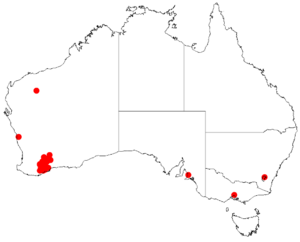Acacia consobrina facts for kids
Acacia consobrina is a type of shrub that belongs to the Acacia family. It is a special plant because it grows naturally only in the southwestern part of Australia. This means it is an endemic species there.
Quick facts for kids Acacia consobrina |
|
|---|---|
| Scientific classification | |
| Genus: |
Acacia
|
| Species: |
consobrina
|
 |
|
| Occurrence data from AVH | |
What it Looks Like
This rounded, spreading shrub usually grows to be about 0.5 to 1.5 meters (1.6 to 4.9 feet) tall. Its small branches are often hairy. These hairs can be golden, especially on new growth.
Like most Acacia plants, it has phyllodes instead of true leaves. Phyllodes are flattened leaf stems that look and act like leaves. The phyllodes of Acacia consobrina are tough and hairy. They are shaped like a narrow spoon or oblong.
Each phyllode is about 2.5 to 4 centimeters (1 to 1.6 inches) long and wide. They have many raised lines, or nerves, on their surface. This plant blooms from May to September. During this time, it produces bright yellow flowers.
How it Got its Name
Scientists Richard Sumner Cowan and Bruce Maslin first officially described this plant in 1990. They wrote about it in a scientific paper called Acacia Miscellany. This paper was published in a journal called Nuytsia.
For a short time in 2003, another scientist, Leslie Pedley, changed its name to Racosperma consobrinum. But by 2006, it was moved back to the Acacia family. Sometimes, people might confuse this plant with another similar one called Acacia ixiophylla. Acacia consobrina is also closely related to Acacia flavipila. It looks a bit like Acacia caesariata and Acacia verricula too.
Where it Grows
Acacia consobrina is found in the Wheatbelt and Great Southern areas of Western Australia. It likes to grow on gently rolling sandy plains. It also grows on flat areas where soil has washed down from hills.
You can often find it in sandy-clay, loamy-clay, or clay soils. Even though it is common in these regions, it grows in scattered patches. You might see it from Karlgarin in the north. It also grows near Gnowangerup in the southwest and Jerramungup in the southeast. It is usually part of low Eucalyptus forests or open areas with many shrubs.

